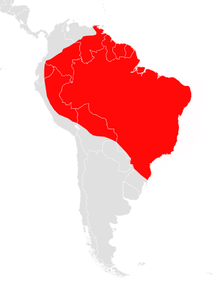Dark fruit-eating bat
| Dark fruit-eating bat | |
|---|---|
 | |
Conservation status | |
| Scientific classification | |
| Domain: | Eukaryota |
| Kingdom: | Animalia |
| Phylum: | Chordata |
| Class: | Mammalia |
| Order: | Chiroptera |
| Family: | Phyllostomidae |
| Genus: | Artibeus |
| Species: | A. obscurus |
| Binomial name | |
| Artibeus obscurus Wied-Neuwied, 1826 | |
 | |
| Dark Fruit-eating Bat range | |
| Synonyms | |
| Artibeus fuliginosus | |
The dark fruit-eating bat (Artibeus obscurus), is a bat species from South America.
Description
Dark fruit-eating bats are relatively small, with an average body length of 8 cm (3.1 in), and weighing from 30 to 52 g (1.1 to 1.8 oz). Their fur is longer and darker than that of their closest relatives, being dark brown to sooty black over most of the body, with a white frosting. The underparts are paler, and there are also faint stripes of pale fur on the face. The nose-leaf is broad, with a distinct horseshoe separated from the upper lip. The snout is relatively narrow for a bat of its small size, and the ears are rounded, with a sharply pointed tragus.[2]
Distribution and habitat
Dark-fruit eating bats are found throughout the Amazon Basin. They are known from all but the southernmost parts of Brazil, from the Guyanas, and from the Amazonian regions of countries from Venezuela to Bolivia. They inhabit rainforests from sea level to 1,400 m (4,600 ft), and, in the southern part of their range, savannah and patchy semi-deciduous forests. There are no recognised subspecies.[2][3]
Biology
The bats are generally low-flying, travelling close to the ground through forested terrain. They spend the day roosting under leaves or flaking pieces of bark about 4 to 7 m (13 to 23 ft) above the ground.[2] They feed on figs, and the fruit of trees such as shimbillo and uvilla.[4] Mating takes place between September and November, and results in the birth of a single offspring.[2]
Gallery
-
 Artibeus obscurus and its teeth
Artibeus obscurus and its teeth -
 Artibeus obscurus skull
Artibeus obscurus skull -

-

References
- ^ Sampaio, E.; Lim, B.; Peters, S. (2016). "Artibeus obscurus". IUCN Red List of Threatened Species. 2016: e.T2137A21998064. doi:10.2305/IUCN.UK.2016-2.RLTS.T2137A21998064.en. Retrieved 12 November 2021.
- ^ a b c d Haynes, M.A.; Lee, T.E. (2004). "Artibeus obscurus". Mammalian Species. 752: Number 752: pp. 1–5. doi:10.1644/752.
- ^ "ADW: Artibeus obscurus: CLASSIFICATION".
- ^ Davis, W.B.; Dixon, J.R. (1976). "Activity of bats in a small village clearing near Iquitos, Peru". Journal of Mammalogy. 57 (4): 747–749. doi:10.2307/1379444. JSTOR 1379444.
- v
- t
- e
- Kingdom: Animalia
- Phylum: Chordata
- Class: Mammalia
- Infraclass: Eutheria
- Superorder: Laurasiatheria
- Order: Chiroptera
| |||||||||||||||||||||||||
|---|---|---|---|---|---|---|---|---|---|---|---|---|---|---|---|---|---|---|---|---|---|---|---|---|---|
| |||||||||||||||||||||||||
Subfamily Glossophaginae | |||||||||||||||||||||||||||||||||||||||
|---|---|---|---|---|---|---|---|---|---|---|---|---|---|---|---|---|---|---|---|---|---|---|---|---|---|---|---|---|---|---|---|---|---|---|---|---|---|---|---|
| |||||||||||||||||||||||||||||||||||||||
Subfamily Phyllostominae | |||||||||||||||||||||||||||||||||||||||||
|---|---|---|---|---|---|---|---|---|---|---|---|---|---|---|---|---|---|---|---|---|---|---|---|---|---|---|---|---|---|---|---|---|---|---|---|---|---|---|---|---|---|
| |||||||||||||||||||||||||||||||||||||||||
Subfamily Stenodermatinae | |||||||||||||||||||||||||||||||||||||||||
|---|---|---|---|---|---|---|---|---|---|---|---|---|---|---|---|---|---|---|---|---|---|---|---|---|---|---|---|---|---|---|---|---|---|---|---|---|---|---|---|---|---|
| |||||||||||||||||||||||||||||||||||||||||















